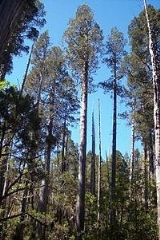
Antarctic Floristic Kingdom
Encyclopedia
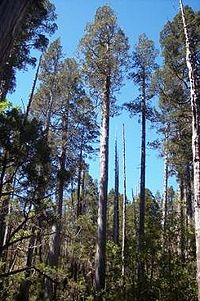
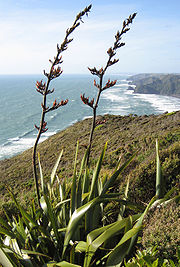
Armen Takhtajan
Armen Leonovich Takhtajan or Takhtajian , was a Soviet-Armenian botanist, one of the most important figures in 20th century plant evolution and systematics and biogeography. His other interests included morphology of flowering plants, paleobotany, and the flora of the Caucasus...
), which includes most areas of the world south of 40°S
40th parallel south
The 40th parallel south is a circle of latitude that is 40 degrees south of the Earth's equatorial plane. It crosses the Atlantic Ocean, the Indian Ocean, Australasia, the Pacific Ocean and South America....
latitude
Latitude
In geography, the latitude of a location on the Earth is the angular distance of that location south or north of the Equator. The latitude is an angle, and is usually measured in degrees . The equator has a latitude of 0°, the North pole has a latitude of 90° north , and the South pole has a...
. The Antarctic plant kingdom includes the continent of Antarctica, Patagonia
Patagonia
Patagonia is a region located in Argentina and Chile, integrating the southernmost section of the Andes mountains to the southwest towards the Pacific ocean and from the east of the cordillera to the valleys it follows south through Colorado River towards Carmen de Patagones in the Atlantic Ocean...
(southern Chile
Chile
Chile ,officially the Republic of Chile , is a country in South America occupying a long, narrow coastal strip between the Andes mountains to the east and the Pacific Ocean to the west. It borders Peru to the north, Bolivia to the northeast, Argentina to the east, and the Drake Passage in the far...
, southern Argentina
Argentina
Argentina , officially the Argentine Republic , is the second largest country in South America by land area, after Brazil. It is constituted as a federation of 23 provinces and an autonomous city, Buenos Aires...
, Tierra del Fuego
Tierra del Fuego
Tierra del Fuego is an archipelago off the southernmost tip of the South American mainland, across the Strait of Magellan. The archipelago consists of a main island Isla Grande de Tierra del Fuego divided between Chile and Argentina with an area of , and a group of smaller islands including Cape...
), most of New Zealand
New Zealand
New Zealand is an island country in the south-western Pacific Ocean comprising two main landmasses and numerous smaller islands. The country is situated some east of Australia across the Tasman Sea, and roughly south of the Pacific island nations of New Caledonia, Fiji, and Tonga...
, the New Zealand Sub-Antarctic Islands
New Zealand sub-antarctic islands
The five southernmost groups of the New Zealand Outlying Islands form the New Zealand Sub-Antarctic islands. These islands are collectively designated as an UNESCO World Heritage Site....
, and all islands of the Southern Ocean
Southern Ocean
The Southern Ocean comprises the southernmost waters of the World Ocean, generally taken to be south of 60°S latitude and encircling Antarctica. It is usually regarded as the fourth-largest of the five principal oceanic divisions...
south of 40°S latitude, including Gough Island
Gough Island
Gough Island , also known historically as Gonçalo Álvares or Diego Alvarez, is a volcanic island in the South Atlantic Ocean. It is a dependency of Tristan da Cunha and part of the British overseas territory of Saint Helena, Ascension and Tristan da Cunha...
, the Kerguelen Islands
Kerguelen Islands
The Kerguelen Islands , also known as the Desolation Islands, are a group of islands in the southern Indian Ocean constituting the emerged part of the otherwise submerged Kerguelen Plateau. The islands, along with Adélie Land, the Crozet Islands and the Amsterdam and Saint Paul Islands are part of...
, and the Falkland Islands
Falkland Islands
The Falkland Islands are an archipelago in the South Atlantic Ocean, located about from the coast of mainland South America. The archipelago consists of East Falkland, West Falkland and 776 lesser islands. The capital, Stanley, is on East Falkland...
. Tasmania
Tasmania
Tasmania is an Australian island and state. It is south of the continent, separated by Bass Strait. The state includes the island of Tasmania—the 26th largest island in the world—and the surrounding islands. The state has a population of 507,626 , of whom almost half reside in the greater Hobart...
is omitted since its plant species are more closely related to those found in the Australian Floristic Kingdom. Good noted, as had Joseph Dalton Hooker
Joseph Dalton Hooker
Sir Joseph Dalton Hooker OM, GCSI, CB, MD, FRS was one of the greatest British botanists and explorers of the 19th century. Hooker was a founder of geographical botany, and Charles Darwin's closest friend...
much earlier, that many plant species of Antarctica, temperate South America and New Zealand were very closely related, despite their disjunction
Disjunct distribution
In biology, a taxon with a disjunct distribution is one that has two or more groups that are related but widely separated from each other geographically...
by the vast Southern Ocean
Southern Ocean
The Southern Ocean comprises the southernmost waters of the World Ocean, generally taken to be south of 60°S latitude and encircling Antarctica. It is usually regarded as the fourth-largest of the five principal oceanic divisions...
. The flora of this kingdom
Antarctic flora
The Antarctic flora is a distinct community of vascular plants which evolved millions of years ago on the supercontinent of Gondwana, and is now found on several separate areas of the Southern Hemisphere, including southern South America, southernmost Africa, New Zealand, Australia and New Caledonia...
dates back to the time of Gondwana
Gondwana
In paleogeography, Gondwana , originally Gondwanaland, was the southernmost of two supercontinents that later became parts of the Pangaea supercontinent. It existed from approximately 510 to 180 million years ago . Gondwana is believed to have sutured between ca. 570 and 510 Mya,...
, the southern supercontinent
Supercontinent
In geology, a supercontinent is a landmass comprising more than one continental core, or craton. The assembly of cratons and accreted terranes that form Eurasia qualifies as a supercontinent today.-History:...
which once included most of the landmasses of the present-day Southern Hemisphere
Southern Hemisphere
The Southern Hemisphere is the part of Earth that lies south of the equator. The word hemisphere literally means 'half ball' or "half sphere"...
, though it has been influenced by the flora of the Holarctic Kingdom since the Tertiary
Tertiary
The Tertiary is a deprecated term for a geologic period 65 million to 2.6 million years ago. The Tertiary covered the time span between the superseded Secondary period and the Quaternary...
.
According to Ronald Good, about 50 genera of vascular plants are common in the Antarctic plant kingdom, including Nothofagus
Nothofagus
Nothofagus, also known as the southern beeches, is a genus of 35 species of trees and shrubs native to the temperate oceanic to tropical Southern Hemisphere in southern South America and Australasia...
and Dicksonia
Dicksonia
Dicksonia is a genus of tree ferns in the order Cyatheales. It is regarded as related to Cyathea, but is considered more primitive, dating back at least to the Jurassic and Cretaceous periods. The fossil record includes stems, pinnules, and spores....
. Takhtajan also made note of hundreds of other vascular plant genera scattered about and isolated on islands of the Southern Ocean, including Calandrinia feltonii of the Falkland Islands, Pringlea antiscorbutica of the Kerguelen Islands, and the megaherb
Megaherb
Megaherbs are a group of herbaceous perennial wildflowers growing in the New Zealand sub-antarctic islands. They are characterised by their great size, with huge leaves and very large and often unusually-coloured flowers, which have evolved as an adaptation to the harsh weather conditions on the...
genera of the New Zealand Sub-Antarctic Islands.
According to Takhtajan, 11 families
Family (biology)
In biological classification, family is* a taxonomic rank. Other well-known ranks are life, domain, kingdom, phylum, class, order, genus, and species, with family fitting between order and genus. As for the other well-known ranks, there is the option of an immediately lower rank, indicated by the...
are endemic to this kingdom: Lactoridaceae, Gomortegaceae, Hectorellaceae, Halophytaceae
Halophytaceae
Halophytum ameghinoi is a species of herbaceous plant endemic to Patagonia. It is a succulent annual plant, with simple, fleshy, alternate leaves. The plants are monoecious, with solitary female flowers and inflorescences of male flowers on the same plant .Halophytum has sometimes been placed...
, Francoaceae
Francoaceae
The Francoaceae are a small family of plants, including the genus Francoa, commonly known as Bridal Wreaths. There are two genera, each with a single species....
, Aextoxicaceae, Tribelaceae, Griseliniaceae, Misodendraceae
Misodendraceae
Misodendron is a genus of hemiparasites which grow as mistletoes on various species of Nothofagus. The twelve species are all restricted to South America.Misodendron is placed in its own family, Misodendraceae, in the order Santalales...
, Alseuosmiaceae
Alseuosmiaceae
Alseuosmiaceae is a plant family of the order Asterales, found in Australia, New Caledonia and New Zealand.They are shrubs with simple, alternate leaves, spiral or whorled, with entire or dentate margins. The solitary flowers are terminal or axillary, or aggregated in fascicles and rarely in...
and Donatiaceae.
Subdivisions
The Antarctic floristic kingdom is subdivided into four floristic regions, and subdivided even further into sixteen floristic provinceFloristic province
A phytochorion, in phytogeography, is a geographic area with a relatively uniform composition of plant species. Adjacent phytochoria do not usually have a sharp boundary, but rather a soft one, a transitional area in which many species from both regions overlap...
s. Most of the provinces lie within, or very near the Antarctic convergence
Antarctic Convergence
The Antarctic Convergence is a curve continuously encircling Antarctica where cold, northward-flowing Antarctic waters meet the relatively warmer waters of the subantarctic. Antarctic waters predominantly sink beneath subantarctic waters, while associated zones of mixing and upwelling create a zone...
zone.
Fernandezian Region
(often included within the Neotropical Kingdom) Endemic family: Lactoridaceae; endemic genera: 20, including ThyrsopterisThyrsopteris
Thyrsopteris is a predominant plant genus in the Juan Fernandez Archipelago. It is a tree fern genus with a single species, Thyrsopteris elegans, in the family Thyrsopteridaceae....
, Nothomyrcia, Selkirkia
Selkirkia
Selkirkia is a genus of predatory priapulid worm known from the Middle Cambrian Burgess Shale. In the Burgess Shale, 20% of the tapering, organic-walled tubes are preserved with the worm inside them, whereas the other 80% are empty...
, Cuminia
Cuminia
Cuminia is a genus of flowering plant in the Lamiaceae family.It contains the following species:* Cuminia eriantha* Cuminia fernandezia...
, Juania
Juania
Juania australis, the Chonta Palm, is a species of flowering plant in the Arecaceae family, the only species in the genus Juania. It is a solitary trunked palm tree which is endemic to the Juan Fernández Islands archipielago in the southeast Pacific Ocean west of Chile.This palm is slow growing and...
, Robinsonia
Robinsonia
Robinsonia is a genus of moth in the family Arctiidae. It usually lives on clothes.-References:*...
, Rhetinodendron, Symphyochaeta, Centaurodendron
Centaurodendron
Centaurodendron is a genus of flowering plant in the Asteraceae family.It contains the following species:* Centaurodendron dracaenoides* Centaurodendron palmiforme...
, Yunquea, Hesperogreigia, Podophorus
Podophorus
Podophorus is a genus of grass in the Poaceae family.- External links :*...
, Pantathera and Megalachne
Megalachne
Megalachne is a genus of grass in the Poaceae family.-External links:*...
. Species endemism of vascular plants is very high (about 70%).
-
- Fernandezian Province
Argentina-Chile-Patagonian Region
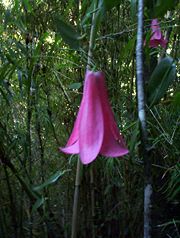
Halophytaceae
Halophytum ameghinoi is a species of herbaceous plant endemic to Patagonia. It is a succulent annual plant, with simple, fleshy, alternate leaves. The plants are monoecious, with solitary female flowers and inflorescences of male flowers on the same plant .Halophytum has sometimes been placed...
, Malesherbiaceae, Tribelaceae, Francoaceae
Francoaceae
The Francoaceae are a small family of plants, including the genus Francoa, commonly known as Bridal Wreaths. There are two genera, each with a single species....
, Aextoxicaceae, Misodendraceae
Misodendraceae
Misodendron is a genus of hemiparasites which grow as mistletoes on various species of Nothofagus. The twelve species are all restricted to South America.Misodendron is placed in its own family, Misodendraceae, in the order Santalales...
, many endemic genera (including Leptocionium, Saxegothaea
Saxegothaea
Saxegothaea is a genus comprising a single species of conifer belonging to the podocarp family Podocarpaceae, its full scientific name is Saxegothaea conspicua, native to southern South America...
, Austrocedrus
Austrocedrus
Austrocedrus is a genus of conifer belonging to the cypress family Cupressaceae. It has only one species, Austrocedrus chilensis, native to the Valdivian temperate rain forests and the adjacent drier steppe-forests of central-southern Chile and western Argentina from 33°S to 44°S latitude...
, Pilgerodendron
Pilgerodendron
Pilgerodendron is a genus of conifer belonging to the cypress family Cupressaceae. It has only one species, Pilgerodendron uviferum, and is endemic to the Valdivian temperate rain forests and Magellanic subpolar forests of southern Chile and southwestern Argentina. It grows from 40 to 55°S in...
, Fitzroya
Fitzroya
Fitzroya is a monotypic genus in the cypress family.-Species:The single living species, Fitzroya cupressoides, is a tall, long-lived conifer native to the Andes mountains of southern Chile and Argentina, where it is an important member of the Valdivian temperate rain forests...
, Peumus, Boquila
Boquila
Boquila is a monotypic genus of flowering plants in the Lardizabalaceae family, native to temperate forests of central and southern Chile and Argentina. The sole species is Boquila trifoliata, known as Pilpil, Voqui, Voquicillo, VOoquillo, Voqui blanco in Chile. It bears an edible fruit ....
, Lardizabala
Lardizabala
Lardizabala is a monotypic genus of flowering plants. These plants are evergreen lianas, native to temperate forests of central and southern Chile....
, Philippiella, Austrocactus
Austrocactus
Austrocactus is a genus of cacti with five species endemic of southern South America, in Argentina and Chile.They have solitary o branched bodies, the ribs may have tubercules and they are not very spiny. The tallest species in this genus is 24 inches. Flowers are pink, red or yellow with a...
, Holmbergia, Berberidopsis
Berberidopsis
Berberidopsis is a genus of flowering plants in the small family Berberidopsidaceae. It consists of two species:* Berberidopsis beckleri - montane tape vine, of Australia....
, Niederleinia, Lebetanthus, Ovidia, Quillaja
Quillaja
Quillaja is a genus of flowering plants, the only genus in the family Quillajaceae. It was once thought to be in the rose family, Rosaceae, but recent research shows it belongs in its own family. The inner bark of the soap bark tree contains saponin, which is a natural soap. Members of this...
, Kageneckia
Kageneckia
Kageneckia is a genus of flowering plant in family Rosaceae.Species include:* Kageneckia angustifolia, D. Don* Kageneckia lanceolata, Ruiz & Pav.* Kageneckia oblonga, Ruiz & Pav....
, Saxifragella, Zuccagnia
Zuccagnia
Zuccagnia is a genus of flowering plants in the legume family, Fabaceae. It belongs to the subfamily Caesalpinioideae....
, Tepualia
Tepualia
Tepualia is a monotypic genus of the myrtle family containing only the species Tepualia stipularis, which is commonly known as tepú, trepú, or tepual. It is an evergreen tree or shrub that can attain a height of about seven metres...
, Magallana, Gymnophyton, Laretia, Mulinum, Talguenea, Schizanthus
Schizanthus
Schizanthus ,—common names butterfly flower, fringeflower, poor-man's-orchid—is a genus of plants in the Solanaceae family....
, Melosperma, Monttea, Hygea, Mitraria
Mitraria
Mitraria is a genus of flowering plants in the family Gesneriaceae, comprising the sole species M. coccinea ....
, Sarmienta, Chiliotrichum
Chiliotrichum
Chiliotrichum is a genus of flowering plants in the daisy family, Asteraceae. - Further Reading :*Bonifacino, José Mauricio. 2009. Taxonomic Revision of the Chiliotrichum group sensu stricto Smithsonian Contributions to Botany, no. 92, vi+119 pp. Washington, D.C.: Smithsonian Institution...
, Melalema, Nassauvia
Nassauvia
Nassauvia is a genus of flowering plants in the aster family, Asteraceae. It is said to be chocolate scented.It consists of 39 species and is native to Argentina, Bolivia, Chile and the Falkland Islands.- Selected species :...
, Tetroncium, Gilliesia, Leontochir, Leucocryne, Schickendantziella, Solaria
Solaria
Solaria was a fictional human-inhabited planet in Isaac Asimov's Foundation and Robot series.It was the last of fifty Spacer worlds colonized by humans in a first wave of interstellar settlement. Occupied from approximately 4270 AD by inhabitants of the neighboring world Nexon originally for summer...
, Lapageria, Conanthera
Conanthera
Conanthera is a genus of 3-4 species small Chilean bulbous plants with small panicles of blue, purple or white and purple flowers Propagation is by offsets or seed.-External links:*...
, Tecophilaea, Tapeinia
Tapeinia
Tapeinia is a genus of flowering plants in the family Iridaceae. The genus name is derived from the Greek word tapeinos, meaning "low"....
, Fascicularia
Fascicularia
Fascicularia is a genus of the botanical family Bromeliaceae, subfamily Bromelioideae. The genus name is from the Latin “fasciculus” and “arius”...
, Ortachne
Ortachne
Ortachne is a genus of grass in the Poaceae family.- External links :*...
, Jubaea
Jubaea
Jubaea chilensis is the sole extant species in the genus Jubaea in the palm family Arecaceae. It is native to southwestern South America, where it is endemic to a small area of central Chile, between 32°S and 35°S in southern Coquimbo, Valparaíso, Santiago, O'Higgins and northern Maule regions...
) and species.
-
- Northern Chilean Province
- Central Chilean Province
- Argentine Pampas Province
- Patagonian Province
- Tierra del Fuego Province
Neozeylandic Region
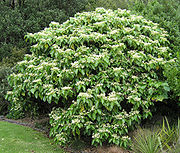
Pseudowintera
Pseudowintera is a genus of woody evergreen flowering trees and shrubs, part of family Winteraceae. The species of Pseudowintera are native to New Zealand. Winteraceae are magnoliids, associated with the humid Antarctic flora of the southern hemisphere. Horopito can be chewed for a hot, peppery...
, Hectorella, Entelea
Entelea
Entelea arborescens or whau is a species of malvaceous tree endemic to New Zealand. E. arborescens is the only species in the genus Entelea. A shrub or small tree to 6 m with large lime-like leaves giving a tropical appearance, whau grows in low forest along the coast of the North Island and...
, Hoheria
Hoheria
Hoheria is a genus of six species of flowering plants in the family Malvaceae. All are endemic to New Zealand and the Kermadec Islands. The genus name is a Latinization of the Māori language name, Houhere...
, Corokia
Corokia
Corokia is a genus in the Argophyllaceae family comprising about ten species native to New Zealand and one native to Australia. Corokia species are shrubs or small trees with zigzagging branches. In fact, Corokia cotoneaster is commonly known as wire-netting bush. The stems of the shrubs are dark...
, Alseuosmia
Alseuosmia
Alseuosmia is a plant genus in the family Alseuosmiaceae. Species members are characteristically small evergreen shrubs. An example occurrence of species representative Alseuosmia macrophylla is in the New Zealand North Island habitat of the Hamilton Ecological District, where Blechnum discolor and...
, Carmichaelia, Lophomyrtus
Lophomyrtus
Lophomyrtus is a genus of the myrtle family native to New Zealand. It has two species, both evergreen shrubs or trees, noted for their colorful leaves, which are purple, chocolate, red or bronze-green. There are also a number of cultivars. Planting in full sun aids the leaf color to develop. In...
, Neomyrtus, Plectomirtha, Stilbocarpa
Stilbocarpa
Stilbocarpa is a genus of flowering plant most often placed in the family Araliaceae; it might be closer to the Apiaceae however. It comprises 3 species, two of which are endemic to New Zealand, while one is also found on Australia's subantarctic Macquarie Island....
, Kirkophytum, Coxella, Lignocarpa, Scandia
Scandia
Scandia was a name used for various uncharted islands in Northern Europe by the first Greek and Roman geographers. The name originated in Greek sources, where it had been used for a long time for different islands in the Mediterranean region...
, Dactylanthus, Myosotidium
Myosotidium
Myosotidium is a genus of plants belonging to the family Boraginaceae. This genus is represented by the single species Myosotidium hortensia, the Chatham Islands forget-me-not, which is endemic to the Chatham Islands, New Zealand....
, Parahebe, Negria, Rhabdothamnus, Teucridium, Oreostylidium
Oreostylidium
Oreostylidium is a genus of flowering plants in the family Stylidiaceae with a single species, Oreostylidium subulatum, that is endemic to New Zealand. O. subulatum is a very small plant with small, white flowers. It has a complicated botanical history that has led to a few proposals to move...
, Pachystegia, Haastia
Haastia
Haastia is a genus of flowering plants in the daisy family, Asteraceae....
, Leucogenes, Phormium, Rhopalostylis
Rhopalostylis
Rhopalostylis is a genus of two species of palms native to the South Pacific. Both are smooth-trunked, with regular ringed scars from fallen leaves. The leaves are 3–5 metres in length, and the leaf bases encircle the trunk.-Distribution:R...
, Lepidorrhachis
Lepidorrhachis
Lepidorrhachis is a monotypic genus of flowering plant in the palm family restricted to Lord Howe Island. The genus name for the single, monoecious species, Lepidorrhachis mooreana, comes from two Greek word meaning "scale" and "rachis", and the epithet honors Charles Moore, first director of the...
, Hedyscepe
Hedyscepe
Hedyscepe canterburyana, the Big Mountain Palm or Umbrella Palm, is the sole species in the genus Hedescepe of the Arecaceae family. It is endemic to Lord Howe Island, Australia and is threatened by habitat loss. It is a solitary palm with a distinct crownshaft, and bears unisexual flowers of both...
, Howea
Howea
Howea is a genus of two palms, H. belmoreana and H. forsteriana, both endemic to Lord Howe Island, Australia. H. forsteriana in particular is commonly grown as an indoor plant in the Northern Hemisphere, and the two species form the mainstay of the island's palm seed industry and more importantly...
, Sporadanthus, Aporostylis
Aporostylis
Aporostylis is a genus of flowering plants from the orchid family, Orchidaceae.- References :*Pridgeon, A.M., Cribb, P.J., Chase, M.A. & Rasmussen, F. eds. . Genera Orchidacearum 1. Oxford Univ. Press....
, Desmoschoenus), very high species endemism, especially among Pinophyta
Pinophyta
The conifers, division Pinophyta, also known as division Coniferophyta or Coniferae, are one of 13 or 14 division level taxa within the Kingdom Plantae. Pinophytes are gymnosperms. They are cone-bearing seed plants with vascular tissue; all extant conifers are woody plants, the great majority being...
.
-
- Lord Howe Province
- Norfolkian Province
- Kermadecian Province
- Northern Neozeylandic Province
- Central Neozeylandic Province
- Southern Neozeylandic Province
- Chatham Province
- New Zealand Subantarctic Islands Province

